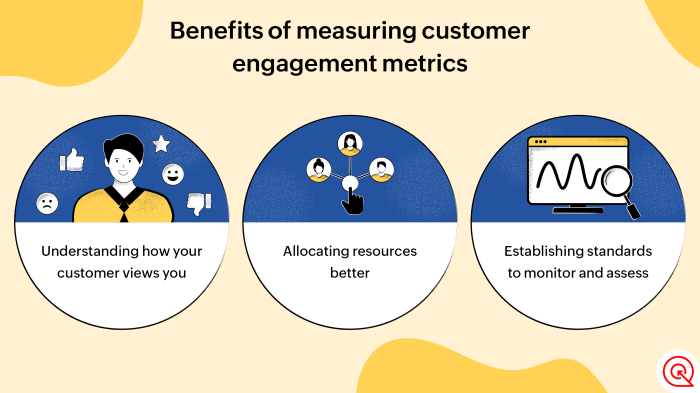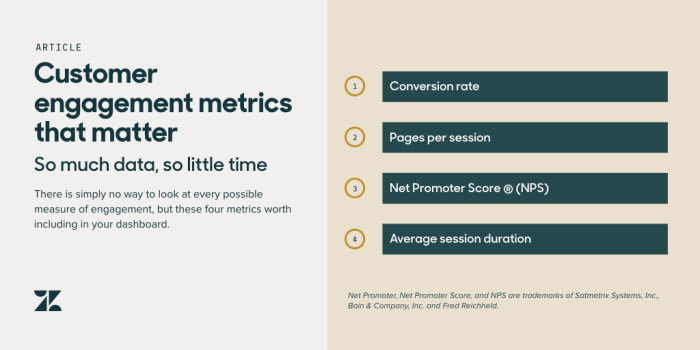Understanding Content Engagement Metrics takes center stage, inviting readers into a world of digital marketing insights. Dive into the realm of tracking and analyzing metrics to elevate your online presence.
Introduction to Content Engagement Metrics
Content engagement metrics are data points that marketers use to measure how audiences interact with their content. These metrics provide insights into how effective content is at capturing and retaining the attention of the target audience.Tracking content engagement metrics is crucial for evaluating the success of digital marketing campaigns. By analyzing these metrics, marketers can understand what content resonates with their audience, identify areas for improvement, and optimize their strategies to drive better results.
Common Content Engagement Metrics
- Page Views: The number of times a page is viewed by users. It indicates the overall traffic to a webpage.
- Time on Page: The average amount of time visitors spend on a webpage. Longer durations may indicate higher engagement.
- Bounce Rate: The percentage of visitors who navigate away from a site after viewing only one page. A high bounce rate could signal that the content is not engaging enough.
- Click-Through Rate (CTR): The percentage of users who click on a specific link. It measures the effectiveness of call-to-action buttons or hyperlinks.
- Social Shares: The number of times content is shared on social media platforms. It reflects audience engagement and brand awareness.
Types of Content Engagement Metrics

When it comes to measuring the success of your content, there are various types of metrics that can provide valuable insights. These metrics can be broadly categorized into quantitative and qualitative metrics, each offering unique perspectives on how your audience interacts with your content.
Quantitative Metrics
Quantitative metrics focus on the numerical data that can be measured and analyzed to gauge the performance of your content. Some key quantitative metrics include:
- Page Views: The total number of times a page has been viewed by users.
- Time on Page: The average amount of time users spend on a particular page.
- Bounce Rate: The percentage of visitors who navigate away from the site after viewing only one page.
Qualitative Metrics
On the other hand, qualitative metrics provide insights into the subjective aspects of audience engagement with your content. Some important qualitative metrics include:
- Social Shares: The number of times your content has been shared on social media platforms.
- Comments: The feedback and interactions users leave on your content.
- Reviews: The ratings and reviews users provide for your content.
By comparing and contrasting different types of content engagement metrics, you can gain a comprehensive understanding of how your audience is interacting with your content. Quantitative metrics give you a clear picture of the reach and engagement levels, while qualitative metrics offer deeper insights into the sentiment and impact of your content on the audience. By analyzing a combination of both quantitative and qualitative metrics, you can make informed decisions to optimize your content strategy and improve audience engagement.
Tools for Measuring Content Engagement

When it comes to measuring content engagement, there are various tools available to help track and analyze metrics effectively. These tools provide valuable insights into how audiences interact with your content, allowing you to make informed decisions to improve engagement and overall performance.
Google Analytics
Google Analytics is one of the most popular tools used to measure content engagement. It allows you to track various metrics such as page views, time spent on page, bounce rate, and conversion rates. By setting up specific goals and tracking codes, you can gain detailed insights into how users are engaging with your content and where improvements can be made.
Hotjar
Hotjar is another powerful tool that provides heatmaps, session recordings, and user feedback to understand how visitors interact with your website. By visualizing user behavior, you can identify areas of high engagement and pinpoint any issues that may be hindering the user experience. This tool is valuable for optimizing content to increase engagement and conversions.
SEMrush
SEMrush is a comprehensive marketing tool that offers content analytics to measure the performance of your content across different channels. It provides insights into rankings, backlinks, and social media engagement, allowing you to track the impact of your content marketing efforts. By analyzing these metrics, you can refine your content strategy for better engagement and visibility.
Step-by-Step Guide: Using Google Analytics
- Sign in to your Google Analytics account and select the website you want to analyze.
- Navigate to the ‘Behavior’ section and click on ‘Site Content’ to view content engagement metrics.
- Explore metrics like page views, average time on page, bounce rate, and conversion rates to understand how users interact with your content.
- Set up specific goals to track conversions and measure the effectiveness of your content.
- Use custom reports and dashboards to monitor content performance and make data-driven decisions to improve engagement.
By leveraging these tools and following a systematic approach to measuring content engagement, you can gain valuable insights and optimize your content strategy for maximum impact.
Interpreting Content Engagement Data: Understanding Content Engagement Metrics
When it comes to content engagement data, interpreting the metrics is crucial for making informed, data-driven decisions that can drive the success of your business. By understanding the trends and patterns in engagement data, you can identify what is working well and what needs improvement in your content strategy.
Significance of Understanding Trends and Patterns
Interpreting content engagement data allows you to see how your audience is interacting with your content. By analyzing metrics such as click-through rates, time spent on page, and social shares, you can gain valuable insights into what resonates with your audience and what doesn’t. This information is essential for optimizing your content to better engage your target audience and drive desired actions.
Examples of Business Strategies Using Engagement Data, Understanding Content Engagement Metrics
- Company A analyzed their content engagement data and found that video content received significantly higher engagement compared to text-based posts. As a result, they shifted their content strategy to focus more on video content, leading to increased user interaction and conversions.
- Company B noticed a drop in engagement on their social media posts during certain times of the day. By analyzing the data, they discovered that their audience was most active in the evenings. They adjusted their posting schedule to align with peak engagement times, resulting in higher visibility and engagement.
- Company C conducted A/B testing on their email marketing campaigns using engagement metrics such as open rates and click-through rates. By comparing the performance of different email designs and subject lines, they were able to optimize their campaigns for higher engagement and conversion rates.
Strategies to Improve Content Engagement
Boosting content engagement is crucial for the success of any brand. By analyzing metrics, you can identify areas for improvement and implement strategies to increase engagement levels.
Role of Personalization and Targeting
Personalization and targeting play a significant role in increasing content engagement. By tailoring your content to specific audience segments based on their preferences, behavior, and demographics, you can create more relevant and engaging experiences for your audience.
Case Studies of Successful Content Engagement Strategies
- 1. Nike’s “Just Do It” Campaign: By tapping into the emotions and values of their target audience, Nike created a powerful and engaging campaign that resonated with consumers worldwide.
- 2. Starbucks Rewards Program: Starbucks leveraged personalized offers and rewards based on customer behavior to increase engagement and loyalty among their customers.
- 3. Red Bull’s Content Marketing: Red Bull is known for its successful content marketing strategies, such as extreme sports events and branded content, that have built a loyal and engaged audience over the years.
